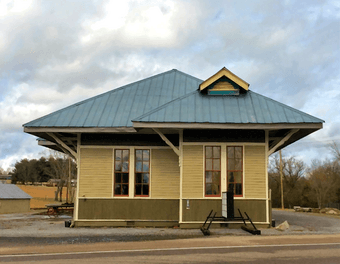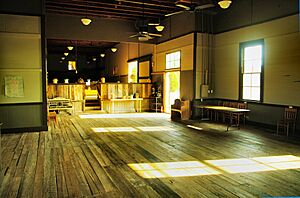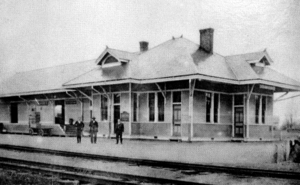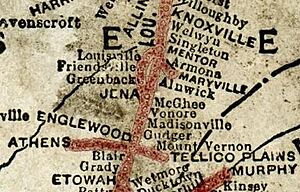Greenback Depot facts for kids
Quick facts for kids |
|
|
Greenback Depot
|
|

Greenback Depot
|
|
| Location | 6736 Morganton Road Greenback, Tennessee |
|---|---|
| Area | Less than one acre |
| Built | 1914 |
| Architectural style | Craftsman |
| NRHP reference No. | 13000950 |
| Added to NRHP | December 18, 2013 |
The Greenback Depot is an old train station in Greenback, Tennessee, United States. It was built in 1914 by the Louisville and Nashville Railroad (L&N) company. This depot was a busy place, handling both train passengers and goods coming into and leaving the Greenback area until 1954.
In the early 2010s, a person named Ronald Edmondson fixed up the depot. Now, it's used as a place for community events. Because of its important role in the area's history, the Greenback Depot was added to the National Register of Historic Places in 2013.
What the Depot Looks Like
The Greenback Depot is a one-story building made of wood. It's about 30 feet (9 meters) wide and 82 feet (25 meters) long. The outside walls are covered with wooden boards called weatherboard and bead board.
This depot was a "combination depot." This means it had space for both people (passengers) and goods (freight) in the same building. Bigger cities often had separate buildings for passengers and freight.
The southern part of the building has a roof that slopes down on all sides, called a hipped roof. It also has small windows sticking out of the roof, called dormers, on the south and west sides. Most of the windows are double-hung sash windows, which means they have two parts that slide up and down. There's also a special window high up on the north wall called a clerestory window. The depot still has its original wooden doors. On the east side, there are large rolling doors for loading and unloading freight.
Inside, the depot is mostly one big open space. There's a small room in the southeast corner that was once a separate waiting room for African Americans. The northern part of the building, which was the freight area, is a little higher than the main part. You have to go up a few steps to get to it. This higher level made it easier to load and unload goods from train cars.
The southern part of the building was for passengers. It originally had three sections:
- The separate waiting room in the southeast corner (which is still a closed-off room).
- A general waiting room in the southwest corner.
- The ticket agent's office next to the waiting rooms.
Between the ticket office and the freight area was a space for luggage. Inside the depot, you can see the wooden beams of the roof, called exposed rafters, and hanging lights. The original roof was made of slate, but it was replaced with a metal roof in the 1980s. That metal roof was replaced again in 2012 and painted gray to look like the original slate roof.
The train tracks used to run along the western side of the depot. The tracks are gone now, but you can still see where they were because there's a gravel path there. This path goes all the way to the Meadow community several miles north. The tracks also crossed Morganton Road and then curved southeast towards the Jena community. The L&N company also had a small freight yard across from the depot, between Morganton Road and Chilhowee Road. The area where the tracks used to be right next to the depot is part of its historic listing.
In 2012, a small addition was built onto the northern end of the depot. This addition has restrooms and a changing room. A covered walkway, called a breezeway, connects this new part to the rest of the building.
History of the Depot
In the late 1880s, a company called the Knoxville Southern Railroad started building a train line. This line was meant to connect Knoxville, Tennessee, with Blue Ridge, Georgia. The train line reached the area that is now Greenback in 1890. At the spot where the train line met Morganton Road, people planned to build a town called "Allegheny."
Lorenzo Thompson, who had started the Greenback Post Office a few miles east in the early 1880s, moved his post office to this new town. Over time, the town became known as "Greenback."
In 1890, the Knoxville Southern Railroad joined with another railroad company. Then, in 1895, this new company was taken over by the Atlanta, Knoxville and Northern Railway. Finally, in 1902, the famous Louisville and Nashville Railroad (L&N) bought the Atlanta, Knoxville and Northern.
For many years, the L&N had avoided building train lines in East Tennessee because of another big railroad company, the Southern Railway. But after the Southern Railway broke an agreement, the L&N started building a major train line. This new line would connect Cincinnati and Atlanta.
The L&N's new Cincinnati-Atlanta line went south from Knoxville through towns like Maryville, Vonore, and Madisonville. It then reached Etowah. (The train tracks along this main line are still used today by CSX).
Near a place called Mentor (just north of modern Alcoa), a side route branched off from the main line. This side route looped around through Louisville, Friendsville, and Greenback. It then rejoined the main line at Jena. In the early 1900s, the L&N built many fancy train stations along this line. This included the large L&N Station in Knoxville and the Etowah Depot. Construction of the Greenback Depot began in 1913 and was finished the next year, in 1914.
William H. Jones was the station agent for Greenback from 1910 until he passed away in 1954. He worked there the entire time the depot was used as a train station. Besides selling train tickets, Mr. Jones also issued hunting, fishing, and marriage licenses from his office in the depot. As a county official, he performed over 3,500 marriage ceremonies, and many of them happened right there in the depot!
By the early 1950s, the L&N stopped carrying passengers to Greenback. They only ran two freight trains to the city. After Mr. Jones died in 1954, the L&N closed the depot.
In 1956, a local group called the Greenback Co-Op (a farmers' cooperative) started renting the depot from the L&N. They used it to store fertilizer. To make more storage space, most of the inside walls were removed. The only part that stayed enclosed was the former separate waiting room, which they used as an office.
When the L&N merged with another company in 1982, the new company sold the depot. From 1983 to 1984, two local people, Bobby and Linda Tarwater, ran an antique store in the depot. After Bobby Tarwater passed away, the depot was sold to Supra Sports, a company that made boats. They used it for their offices. Supra sold the depot to George Fowler in 1989, and Fowler sold it to Larry and Mary Alley in 1999.
The Alleys looked for several years for someone who would care for and preserve the depot. In March 2012, they sold it to Ron Edmondson. Mr. Edmondson removed a fake second story that Supra Sports had added. He also replaced the roof and painted the building to look like it did in the early 1900s. A wooden statue of the Cherokee leader Firekiller, carved by artist Dave LaVoie, has been placed on the depot's property.
| Preceding station | Louisville and Nashville Railroad | Following station | ||
|---|---|---|---|---|
| Friendsville
toward Cincinnati
|
Cincinnati – Atlanta | Jena
toward Atlanta
|
||




